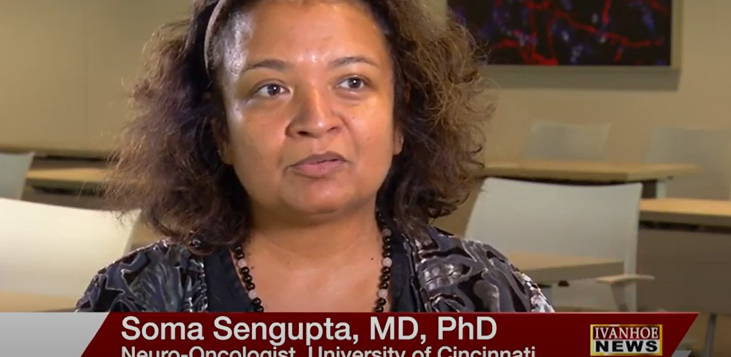Dr. Soma Sengupta, MD, PhD, and Neuro-oncologist at the University of Cincinnati talks about how robotic pet and art therapy can help patients who feel isolated.
If you could tell me a little bit about the robotic pet and art therapy, what are you and your colleagues are looking at?
SENGUPTA: During the pandemic, I read about patients in nursing homes, who were really missing the companionship of pets. There were also New York Times articles about that topic. I love dogs and I have one myself and cats, but I was thinking, what is it that makes a person have an emotional experience due to a pet? And I started looking through the literature and was saddened to find there wasn’t actually something that was really getting at that response. And then the other thing is that, you know, I take care of vestibular schwannoma patients or acoustic neuromas, and a lot of these people after surgery, lose hearing, either in one or both of their ears. And again, during the pandemic, many of the individuals were not able to go and get therapy. And I sort of asked people, what would you like to do? Because obviously, something like a digital music app is not useful here. And I was coloring with my children one day and I thought, you know, this is really cathartic. I had met Meera Rastogi before and I know Meera does some phenomenal work at UC with patients. And I thought, what if I integrated these two concepts? And then when I initially met with Claudia and Meera, they were like, what are you thinking exactly? These are two different things. And I said well, how about if everyone does art therapy in the study and we take half of those people and have them have some kind of pet interaction but using a pet robot? That way the person doesn’t have to walk the pet, take care of the pet but would have a simulated experience. And then we could see whether their mood improves. Because we’re very quick as physicians to give antidepressants to our patients or say OK, yes, yes, you’re feeling sad. Here you go. What about if we could create technologies that would help people’s mood and improve it? And so we wanted to see whether we could create, an interface of these technologies. Dr. Rebola is already funded for pet robot studies. Dr. Rastogi is already known for her art therapy. What if you combine these modalities and digitalize them? You know, so that was the concept there. And we’ve started that. That study is shorter. So we just opened it and there’ll be 10 patients total, five in each arm. 10 will be doing art therapy and five will be doing the pet robot in addition to art therapy. And then within six weeks, we have one of our psych, psychiatry colleagues collaborating with us along with Dr. Rastogi who is also able to interpret the questionnaires. And we’re going to look at mood and how – if that has improved mood within that period.
And is there a clinical component, Dr. Sengupta, that you’re involved with in terms of some of the clients here, the patients?
SENGUPTA: So, all these studies are designed by me. So, whether it’s the chemo brain or this one. I mean, I’ve designed them and so yes, these are groups of patients I work with.
Is there anything else that you would want people to know about this study?
SENGUPTA: I think that this is just the beginning of digitalized technologies. And it was interesting reading a recent post by Forbes where they talked about Apple and Google being interested in this kind of health and wellness-based digitalized technology. It’s not like existing technologies, like Insight Timer App, which are slightly different. This is basically modulated to really cater to one modality at this time. And its connected to sort of an analytic phase. It’s not something that you just do on your own and have no feedback.
Having that component where the patient has some control from home…
SENGUPTA: Yes.
…Is this kind of the way that the future, especially after COVID, are we going to see more of a need? Is this going to be an important part of health care as we go forward having this information technology and all these things that patients can do at home?
SENGUPTA: I think it is. And one thing that’s quite striking actually is that mental health and wellness are not adequately covered. So, if you can basically have interfaces where they can connect to things that would benefit them before a primary care physician starts giving them a medication. These technologies can empower an individual to make themselves feel better rather than, you know, here you go, one-size-fits-all. Perhaps, the way of the future is looking at these digitalized therapies and what’s nice about it is you can have 50 patients sitting in different places and one provider, a psychologist or psychiatrist analyzing the data output. And maybe only one or two of those people actually needs to be on medication. I mean, we’ve entered the world of electronic records, electronic ways of doing things, why can’t we also digitalize health care more?
Interview conducted by Ivanhoe Broadcast News.
END OF INTERVIEW
This information is intended for additional research purposes only. It is not to be used as a prescription or advice from Ivanhoe Broadcast News, Inc. or any medical professional interviewed. Ivanhoe Broadcast News, Inc. assumes no responsibility for the depth or accuracy of physician statements. Procedures or medicines apply to different people and medical factors; always consult your physician on medical matters.
If you would like more information, please contact:
TIM TEDESCHI
Sign up for a free weekly e-mail on Medical Breakthroughs called First to Know by clicking here




